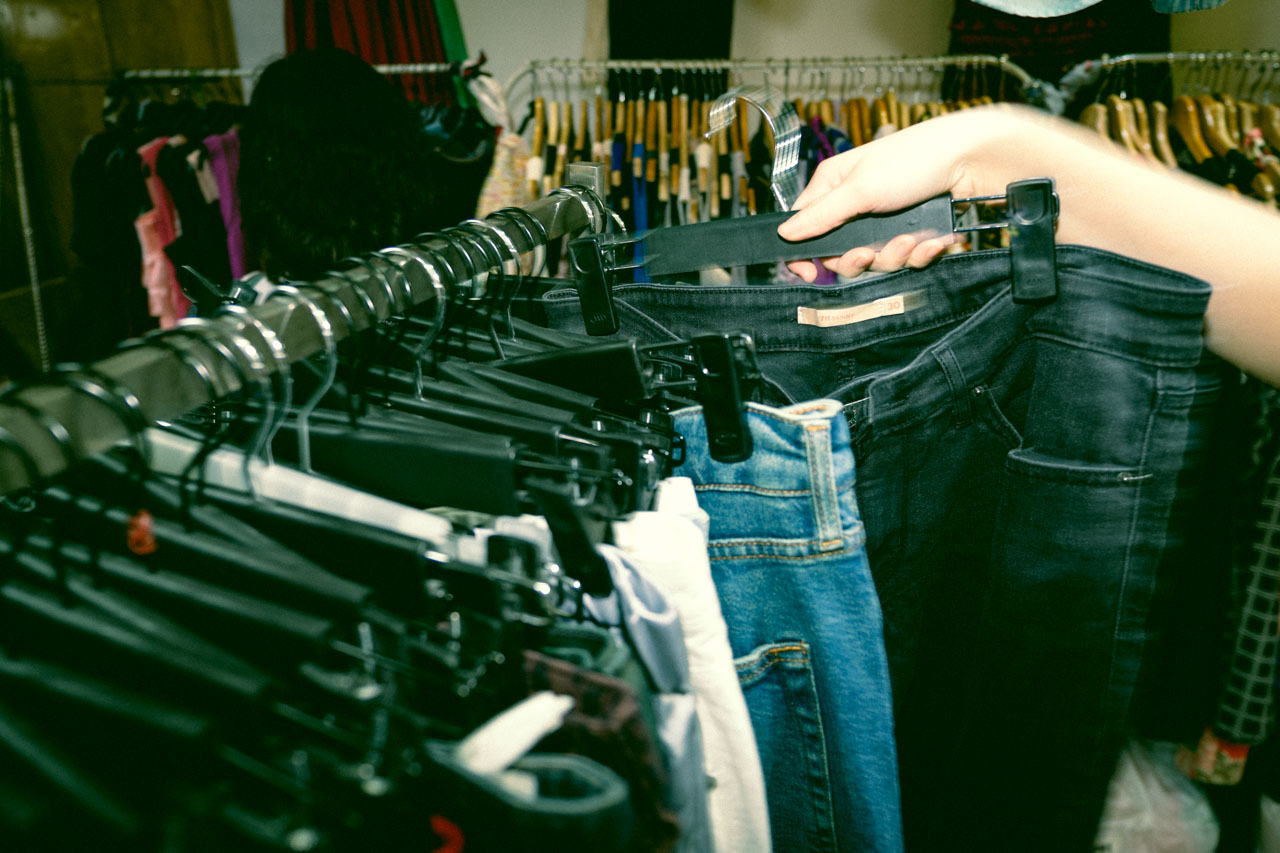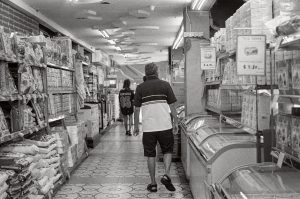All images by Stephanie Lee for RICE Media unless stated otherwise.
When Shawn Guek first started his secondhand clothing store in 2017, there were just a handful of competitors around.
Then 18 years old, his vintage threads sourced within Southeast Asia were considered fashion-forward. Before the Y2K aesthetic blew up, the man was already rocking Champion tees and windbreakers. The only issue: These pieces weren’t easy to acquire in Singapore. So he started sourcing pieces for friends and eventually scaled up into an actual business: oldplusgold.
ADVERTISEMENT
Fast forward six years and secondhand shopping is more mainstream than ever—both in Singapore and abroad.
Watch one thrift haul on TikTok and you’ll be served 10 more. Stores selling pre-loved fashion throng trendy spots like Haji Lane. Even more have mushroomed online. The trend of repurposing used clothing, also known as reworking, has even made its way into the recent season of Netflix reality show Next In Fashion as one of the contestants’ challenges.
Anyone can start a thrift or secondhand store nowadays, Shawn, now 24, tells me. It’s just a matter of sourcing the right pieces and reselling them to a hungry audience.
In fact, savvy shoppers can skip the middleman and buy bales of clothing themselves from places like Malaysia, Thailand and Indonesia. From these bales, shoppers would dive into the pile to extract the few sartorial gems.
Shawn, however, takes a more curated approach. He personally sources everything piece by piece for his online store.
As the secondhand fashion trend grows and competition intensifies, however, is it getting harder for stores to stick to their ethos? How can buyers weed out the duds and find stores that can be trusted?
Fit Check
Shopping for pre-loved clothes is the in thing right now, and Gen Z is leading the charge.
ADVERTISEMENT
Just a decade or so ago, teenagers (me included) were fashion terrorists. We’d trawl Bugis Street and Far East Plaza for trendy streetwear. People would pair capri tights with dresses, belts with tunic tops, and top it off with an owl necklace.
What’s worse, we all thought we were hot shit.
These days, it seems that Gen Z has skipped the ugly duckling stage and gone straight to being bonafide fashionistas. (We millennials are envious as hell).
Of course, there are some younger folks who unabashedly chase the latest trends by buying fast fashion labels such as Shein. After all, unlike the generations before them, they’ve grown up in the era of fast fashion and micro-trends (trends that burst onto the scene and drop off after a season). But a good number of them are big on Y2K fashion and thrifting.
A 2022 report by ThredUp reveals that millennials and Gen Z shoppers embrace secondhand shopping more than the generations before them. A 2021 New Paper article calls it a “niche trend that is also gaining traction in Singapore”.
Shawn believes that more younger kids are into fashion nowadays—he sees a lot more secondary school kids at his store’s pop-up events. “When I was in secondary school, I still dressed like a kid, like a very awkward guy,” he laughs.
“With TikTok, everyone posts outfit checks, even myself. Last time, for example, I was into yo-yos and League of Legends and found cliques with similar interests. Now it feels like if you are well-dressed, you’re that cool kid in school, and it’s easier for you to make friends.”
Chun, 22, who runs Houseofvtg on Instagram, also says his customers are mainly a mix of local Gen Z and millennials.
“I also have international customers, but not that many. The main reason is that the market for pre-owned goods is bigger and more diverse overseas than in Singapore.”
As someone whose tastes transitioned from fast fashion to vintage clothes, Shawn believes pre-loved clothes have the edge when it comes to building a unique wardrobe.
“As a student, I could only afford fast fashion. But my qualm with that is fast fashion doesn’t last very long. And the silhouettes they have are very one dimensional.”
Get Woke, Go Thrifting
It probably also helps that shopping at a thrift store or vintage shop doesn’t feel as guilt-inducing as splashing out on brand-new clothes.
In contrast to fast fashion labels that have no qualms about blatantly ripping off independent brands and artists, secondhand shops are deemed as an ethical alternative.
Besides the chain thrift shops—Salvation Army comes to mind—most of the secondhand shops here are run by independent operators.
Sustainability is obviously a huge selling point for many secondhand stores. A spokesperson for New2U, a non-profit thrift store, says: “By thrifting, we help by reducing the amount of waste that ends up in landfills. We are also extending the lifespan of products by giving them a second chance and preventing them from being discarded prematurely.”
For New2U, it also has social causes it champions—100 percent of proceeds go to the Singapore Council of Women’s Organisations (SCWO).
“At the end of the day, the underlying message from New2U Thrift Shop is that you’re not just thrifting for sustainability and affordability. You’re thrifting for a cause.” Affordable clothes for a good cause—that’s something I can get on board with.
Some of the independent thrift stores have their own pet causes. Besides reducing textile waste, Nightingale Thrift at Queensway Shopping Centre supports the training and employment of autistic people and donates part of its proceeds to needy families.
What Some Secondhand Stores Aren’t Telling You
Among the stores that are genuinely trying to make a difference, though, are some bad eggs. It doesn’t help that new customers hopping on the pre-loved fashion bandwagon might not be the most discerning.
I remember stumbling upon one seller’s Instagram Live sale a few years ago. Sucked in by the ‘vintage’ skirts she was showing, I ended up buying a flowy black number.
When I received it, however, I was disappointed. It wasn’t vintage. Not even close. It was a Uniqlo skirt from a few seasons prior.
Don’t get me wrong—I still like the skirt and wear it to this day. I just don’t like being lied to. ‘Vintage’ usually indicates something produced in an era when things were made to last. And that’s what I thought I was getting.
Vintage and thrift fashion are often mentioned in the same breath, but there’s a subtle and important difference.
Thrift shops encompass anything and everything used or pre-loved. You can find vintage treasures at thrift shops, but you’ll have to do some digging.
Vintage shops, in essence, do the digging for you. They sell curated pieces from brands such as Dickies, Carhartt, Levi’s, and Tommy Hilfiger that are usually at least 20 years old (the generally accepted age for any item of clothing to be considered vintage).
This distinction is important so you know what you’re getting. Prices at thrift stores are usually lower, and prices at vintage stores can run higher, especially for collector’s items.
Any vintage shop worth its salt will check for the authenticity of items, says Shawn. But typically, thrift stores don’t guarantee the authenticity of their items.
Zoe, the 30-year-old owner of Lucky Plaza store Lucky Thrifty, tells me why.
“We don’t really have a need to determine the authenticity of an item as our selling prices are really rock bottom, ranging from $2 to $10.”
The upside, though, is you might be lucky enough to score a branded item for cheap at a thrift store if you know your stuff.
Most thrift stores are upfront about what they offer and their customers are prepared to trawl through racks of clothes to find gems. For me, at least, that’s part of the joy of thrifting.
What isn’t okay is intentionally misleading customers to earn a quick buck.
An all too common trick some sellers use is calling garments ‘vintage’ when they’re merely secondhand, as I’d found out firsthand.
Shawn explains that this is by design. “If you put vintage as a keyword, it automatically gets more views because people are bought into that now.”
The result is a slew of sellers muddying the definitions of ‘vintage’ and ‘secondhand’. Buyers like me, who don’t know better, will think they’re getting a vintage piece for a steal.
Authenticity and Ethics
It gets more unethical. There are also vintage sellers—Shawn declines to name them—who do dropshipping.
With the cyclical nature of fashion, styles from the ‘90s and ‘00s are back in vogue. It’s easier than ever for unethical store owners to source mass-produced fakes. Their modus operandi is to order counterfeit products off sites like Taobao and pass them off as secondhand. And people fall for the trickery.
“In the consumer’s mind, it makes sense. It’s cheaper [than the retail price] because it’s secondhand. But what they don’t know is it’s firsthand but it’s a fake piece,” says Shawn.
But there are signs. Some of these sellers don’t even bother taking their own original photos of the product. Instead, they reuse photos from the Taobao listing.
Similarly, fast fashion sites such as Shein are capitalising on the rise of Y2K and grunge fashion by pumping out items like vintage-looking tees and ‘reworked’ corset tops. For a company notorious for (allegedly) stealing designs, ripping off the vintage aesthetic seems par for the course.
What Shein can’t replicate, though, are the quality and uniqueness of true vintage items.
This is where shops like oldplusgold and Houseofvtg come in. Obviously, they’ll never be as cheap as Shein, but they’ve built customer bases that believe paying for vintage items is worth it. While they can’t compete in price, they’re banking on authenticity to set them apart.
Chun acknowledges the stiff competition in the industry and says all he can do is focus on his niche.
“With more shops popping up—some selling pieces from bales as low as $2 to $5 per piece and rare gems that are priced $100 and above—it becomes crucial to establish a unique selling proposition and differentiate my business from others. Emphasising quality and authenticity becomes even more important for my shop when facing competition.”
As a consumer, it does pay to read up on methods of verifying authenticity, such as looking at the garment’s construction. Shawn’s very passionate about the topic, and he refers me to his blog where he’s written about it in detail.
Identifying vintage items takes skill, and it’s only getting harder. Some vintage resellers know that certain clothing tags will fetch a higher price. They’ll take a tag from an authentic vintage piece, like one from the 70s that is beyond repair, slap it on a reproduced piece, and call it vintage.
“And over the years, [these fakes] are getting so good. The seams are so perfectly lined that you can’t tell with your naked eye. Errors like this happen every now and then. You only can realise it when you have the piece on hand. But that’s one thing to look for.”
Another practice that falls in a moral grey area is grab bags. Some stores suck consumers in with $5 or $10 fill-a-tote promotions, where they have a limited time to stuff as many items as possible into their bags.
It sounds exciting. Until you realise that for a lot of these stores, clearing stock is the main motive. Maybe there are a few nice pieces mixed in so customers don’t catch on, but they’re essentially pushing their dead stock into fresh hands and encouraging impulse buying.
Sure, it’s affordable, but is it really a good deal if you’re walking away with a bunch of clothes that you wouldn’t have picked out under normal circumstances?
For those who are sticking to their guns and trying their best to be responsible sellers like Shawn, it can be disheartening.
“At the end of the day, if you buy it and you don’t wear it, it still ends up in a landfill. What you’re doing is just extending the duration before it ends up in a landfill.”
The Business of Cheap Clothes
While vintage stores focus on curation and sourcing rare items known as ‘grails’, thrift stores play another important role in the secondhand goods ecosystem: Keeping things affordable for those who have to buy pre-loved.
Fortunately, while most of the secondhand stores we spoke to say they’ve seen more interest from consumers, it hasn’t gotten to the extent where things are unaffordable for lower-income groups.
New2U gets its stock from donations. Its spokesperson says, “At New2U Thrift Shop, and as a non-profit organisation, we believe in keeping the prices affordable for all. While we do price luxury items with a higher value, we try as much as possible to keep to standardised price points. For example, all tops and shorts are priced at $4 a piece.”
Zoe says that with the amount that fast fashion brands are producing, there is “always a ton of clothes” available for sale at thrift stores. Meeting the demand for clothes is not the issue.
“The only concern we do have is that when people are dumping more and more of fast fashion clothing, such as Shein. We do receive more, and their quality is indeed worse than before.”
Located in the thrifting haven of Lucky Plaza, Lucky Thrifty started with the goal of providing migrant workers with affordable clothes. Zoe assures that her original aim still guides her pricing, even as she sees a shift in its clientele. Over the years, the store has seen its customer base shift from 70 percent migrant workers to an even 50-50 split with locals.
It’s still a far cry from the situation overseas. In the US, even thrift shops meant for the needy, like Goodwill, are hiking their prices. With thrifting becoming more of a trend than a necessity, some make a living out of reselling thrift finds on Depop.
The Week says secondhand shopping there has “essentially become gentrified because of its trendiness”.
A likely explanation is that thrifting, while growing in popularity here in Singapore, isn’t mainstream yet. Zoe tells me that there’s plenty more space for the industry to grow.
“Look at your local malls. How many secondhand stores are there?”
Standing Firm in a Crowded Market
It’s a tale as old as time. The moment something becomes a trend, it attracts opportunists hoping to capitalise. As thrifting becomes more mainstream, there will always be those who aren’t in it for the right reasons.
Some stores only see dollar signs, but it’s worth noting that there are others standing their ground and staying true to their ideals.
Thrift shops like New2U and Lucky Thrifty are doing their level best to keep fashion affordable. Others in the vintage space, like oldplusgold and Houseofvtg, are doing their part to bring high-quality clothes and wearable pieces of history to their buyers.
Shopping and fashion can be incredibly fun and addictive, regardless of whether you’re buying firsthand or secondhand. But as buyers, we have to be cognizant of the fact that the secondhand fashion scene isn’t immune from the ethical problems that plague the fashion industry.
Beyond finding stores or brands you can trust, the key is to look past cheap price tags and flashy buzzwords (Recycled! Sustainable! Vintage!). It’s all about how you actually feel about a piece before pulling the trigger.





